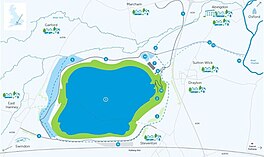| Abingdon Reservoir | |
|---|---|
 2023 Illustration by Thames Water of the conceptual design and location for a 150 Mm reservoir. 2023 Illustration by Thames Water of the conceptual design and location for a 150 Mm reservoir. | |
 | |
| Location | Oxfordshire |
| Coordinates | 51°38′04″N 1°21′15″W / 51.63444°N 1.35417°W / 51.63444; -1.35417 |
| Lake type | Bunded reservoir (Proposed) |
| Primary inflows | River Thames |
| Primary outflows | River Thames |
| Basin countries | United Kingdom |
| Surface area | 6.7 km (670 ha; 1,700 acres) |
| Average depth | 22.4 m (73 ft) |
| Water volume | 150 million cubic metres (150 billion litres; 33 billion imperial gallons; 0.15 cubic kilometres; 0.036 cubic miles) |
The Abingdon Reservoir (also known as the South East Strategic Reservoir Option, or SESRO) is a long-term proposal for fresh water storage for the Home Counties. Located south west of Abingdon, Oxfordshire in the mid-west of the Thames Basin, it is intended to help support water supply provision in the south-east of England. The proposals have been developed with Southern Water and Affinity Water and is intended to serve all three company’s customers.
Proposals
The proposal arose in 2006 by Thames Water. In 2007 the Environment Agency opined that need for this was not proven. Further arguments were put but the near-term-demand case was rejected in 2011. In 2023, following a period of consultation, a revised version increased the proposal to 150 billion litres (150 million cubic metres; 33 billion imperial gallons).
This would make Abingdon the second-largest reservoir in England by capacity, exceeded only by Kielder Water at 200 billion litres (200 million cubic metres; 44 billion imperial gallons), pushing Rutland Water into third place at 124 billion litres (124 million cubic metres; 27 billion imperial gallons). Across the whole of the UK, only seven Scottish lochs have greater freshwater storage by volume.
Since 2018, a longer-term proposal stands, for its building, by 2043 to cater to projected population growth in the Thames Basin.
In early 2025, Thames Water opened discussions with potential contractors about delivery of the reservoir, which would cost up to £2.2bn to build and would then supply water to 15m people across southeast England. Ground investigations were in progress to help inform an application for development consent in 2026. If the consent was granted, construction was expected to start in 2029 for opening in 2040.
Reasons for the construction
See also: Climate of the United Kingdom and Population of the United KingdomThe main reason to build is that the South-East is facing significant seasonal water stress. Factors are the rain shadow behind the prevailing westerly winds and western hills. Eastern counties lack the rainfall of the west; their average annual rainfall being 500-750mm. The west receives around 1800-2800mm.
Average population density is higher in the eastern than western counties; London houses 13.5% of the UK's population. This is the greatest concentration of domestic water usage. Roughly 22% of water use is domestic; 75% is from all types of industry.
Counter-arguments
GARD or the 'Group Against Reservoir Development' have counter-arguments, local, national, and international comparators.
- Thames Water have unambitious targets for leakages
- The reservoir will be far from potent against long droughts
- As there is enough water to supply London now there can be in future using other, sustainable methods.
- Impacts on the ecosystem being transformed from supporting many endangered and protected land-based invertebrates, water voles, bats and hedgehogs to more water-based bird life.
- Traffic congestion and construction pollution.
- Local economic loss of many well-rooted businesses and a solar farm.
- A new, low, risk of flooding.
References
- "New reservoir in Abingdon | Water resources". Thames Water. Retrieved 2023-09-08.
- "South East Strategic Reservoir Option (SESRO) – a new reservoir for the south east". Thames Water Resources Management Plan. 2024-01-29. Retrieved 2024-03-05.
- Reservoir 'biggest in 25 years' - BBC News, 14 September 2006
- "Need for reservoir 'not proven'". BBC News. 5 January 2007. Retrieved 30 August 2009.
- "Abingdon £1bn reservoir plan rejected by government". BBC News. 4 March 2011. Retrieved 7 May 2018.
- Inman, Phillip (2023-04-22). "Lake or mistake? The row over water firms, drought and Abingdon's new super-reservoir". The Observer. ISSN 0029-7712. Retrieved 2023-09-12.
- "Abingdon reservoir proposals questioned by Oxfordshire County Council". BBC News. 18 April 2018. Retrieved 7 May 2018.
- "Abingdon Reservoir back on the cards!". CPRE. 19 February 2018. Retrieved 7 May 2018.
- Morby, Aaron (8 January 2025). "Thames Water bidders day for £2.2bn reservoir scheme". Construction Enquirer. Retrieved 8 January 2025.
- ^ http://www.abingdonreservoir.org.uk/ Group Against Reservoir Development. http://www.abingdonreservoir.org.uk
- Resilience - Final Report. Group Against Reservoir Development. http://www.abingdonreservoir.org.uk
- East Hanney solar farm
External links
- Project homepage by Thames Water
51°38′04″N 1°21′15″W / 51.63444°N 1.35417°W / 51.63444; -1.35417
Categories: